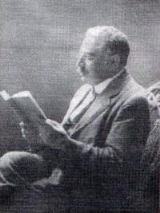
Themistocles Zammit
Encyclopedia
Sir Themistocles Zammit (1864 – 1935) was a Maltese
archaeologist and historian, professor of chemistry, medical doctor, researcher and writer, serving as Rector (1920–26) of the Royal University of Malta
and first Director of the National Museum of Archaeology in Valletta
.
Author of several literary works in the Maltese language, Temi Zammit was conferred the DLitt Honoris Causa by Oxford University. He also published a History of the Maltese Islands and excavated important archaeological sites, such as the Hypogeum and the megalithic Tarxien Temples]], Ħaġar Qim and Mnajdra
, which have since been declared UNESCO World Heritage Sites.Sir Themistocles Zammit (1864 – 1935) was a Maltese archaeologist and historian, professor of chemistry, medical doctor, researcher and writer, serving as Rector (1920–26) of the Royal University of Malta and first Director of the National Museum of Archaeology in Valletta.
Career
After graduating in medicine from the University of Malta, Zammit specialised in bacteriology in London and Paris. His 1905 discovery of contaminated milk as the vector for transmission into humans of brucellosis melitensis present in the blood of the goat – greatly contributed to the elimination from the islands of undulant fever, earning him the knighthood.
Author of several literary works in the Maltese language, Temi Zammit was conferred the DLitt Honoris Causa by Oxford University. He also published a History of the Maltese Islands and excavated important archaeological sites, such as the Hypogeum and the megalithic Tarxien Temples]], Ħaġar Qim and Mnajdra, which have since been declared UNESCO World Heritage Sites.
Legacy
Zammit's scientific approach to archaeology further enhanced his international reputation. A permanent display of some of his findings may be viewed at the National Museum of Archaeology in Valletta.
The main Assembly Hall of the University of Malta was named after him. He also appears on a commemorative 1973 Maltese pound coin.
Read more: http://www.answers.com/topic/themistocles-zammit#ixzz1di1w6eQY
The main Assembly Hall of the University of Malta was named after him. He also appears on a commemorative 1973 Maltese pound coin.
Maltese people
The Maltese are an ethnic group indigenous to the Southern European nation of Malta, and identified with the Maltese language. Malta is an island in the middle of the Mediterranean Sea...
archaeologist and historian, professor of chemistry, medical doctor, researcher and writer, serving as Rector (1920–26) of the Royal University of Malta
University of Malta
The University of Malta is the highest educational institution in Malta Europe and is one of the most respected universities in Europe. The University offers undergraduate Bachelor's Degrees, postgraduate Master's Degrees and postgraduate Doctorates .-History:The University of Malta was founded in...
and first Director of the National Museum of Archaeology in Valletta
Valletta
Valletta is the capital of Malta, colloquially known as Il-Belt in Maltese. It is located in the central-eastern portion of the island of Malta, and the historical city has a population of 6,098. The name "Valletta" is traditionally reserved for the historic walled citadel that serves as Malta's...
.
Career
After graduating in medicine from the University of Malta, Zammit specialised in bacteriology in London and Paris. His 1905 discovery of contaminated milk as the vector for transmission into humans of brucellosis melitensis present in the blood of the goat – greatly contributed to the elimination from the islands of undulant fever, earning him the knighthood.Author of several literary works in the Maltese language, Temi Zammit was conferred the DLitt Honoris Causa by Oxford University. He also published a History of the Maltese Islands and excavated important archaeological sites, such as the Hypogeum and the megalithic Tarxien Temples]], Ħaġar Qim and Mnajdra
Mnajdra
Mnajdra is a megalithic temple complex found on the southern coast of the Mediterranean island of Malta. Mnajdra is approximately 500 metres from the Ħaġar Qim megalithic complex...
, which have since been declared UNESCO World Heritage Sites.Sir Themistocles Zammit (1864 – 1935) was a Maltese archaeologist and historian, professor of chemistry, medical doctor, researcher and writer, serving as Rector (1920–26) of the Royal University of Malta and first Director of the National Museum of Archaeology in Valletta.
Career
After graduating in medicine from the University of Malta, Zammit specialised in bacteriology in London and Paris. His 1905 discovery of contaminated milk as the vector for transmission into humans of brucellosis melitensis present in the blood of the goat – greatly contributed to the elimination from the islands of undulant fever, earning him the knighthood.
Author of several literary works in the Maltese language, Temi Zammit was conferred the DLitt Honoris Causa by Oxford University. He also published a History of the Maltese Islands and excavated important archaeological sites, such as the Hypogeum and the megalithic Tarxien Temples]], Ħaġar Qim and Mnajdra, which have since been declared UNESCO World Heritage Sites.
Legacy
Zammit's scientific approach to archaeology further enhanced his international reputation. A permanent display of some of his findings may be viewed at the National Museum of Archaeology in Valletta.
The main Assembly Hall of the University of Malta was named after him. He also appears on a commemorative 1973 Maltese pound coin.
Read more: http://www.answers.com/topic/themistocles-zammit#ixzz1di1w6eQY
Legacy
Zammit's scientific approach to archaeology further enhanced his international reputation. A permanent display of some of his findings may be viewed at the National Museum of Archaeology in Valletta.The main Assembly Hall of the University of Malta was named after him. He also appears on a commemorative 1973 Maltese pound coin.

